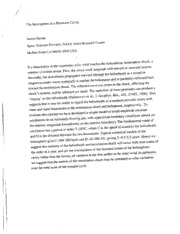
NASA Technical Reports Server (NTRS) 20000093259: The Heliosphere as Resonant Cavity PDF
Preview NASA Technical Reports Server (NTRS) 20000093259: The Heliosphere as Resonant Cavity
i / / .i / The Heliosphere as a Resonant Cavity Aaron Barnes Space Sciences Division, NASA Ames Research Center Moffett Field CA 94035-1000 USA If a disturbance in the supersonic solar wind reaches the heliospheric termination shock, a number of events ensue. First, the shock itself responds with inward or outward motion. Secondly, the disturbance propagates outward through the heliosheath as a sound or magnetoacoustic wave; eventually it reaches the heliopause and is (partially) reflected back toward the termination shock. The reflected wave can return to the shock, affecting the shock's motion, and be reflected yet again. The repetition of these processes can produce a 'ringing' in the heliosheath (Ratkiewicz et al., J. Geophys. Res., 101, 27483, 1996). This suggests that it may be useful to regard the heliosheath as a resonant acoustic cavity with inner and outer boundaries at the termination shock and heliopause, respectively. To evaluate this concept we have developed a simple model of small-amplitude resonant oscillations in an outwardly flowing gas, with appropriate boundary conditions (shock on the interior, tangential discontinuity on the exterior boundary). The fundamental mode of oscillation has a period of order T-2D/C, where C is the speed of sound in the heliosheath and D is the distance between the two boundaries. Typical numerical models of the heliosphere give C-200-500 km/s and D-20-100 AU, giving T~0.5-2.5 years. Hence we suggest that motions of the heliosheath and termination shock will occur with time scales of the order of a year, and are the consequence of the resonant nature of the heliospheric cavity rather than the history of variation at the Sun and/or in the solar wind. In particular, we suggest that the motion of the termination shock may be unrelated to solar variations over the time scale of the sunspot cycle.
